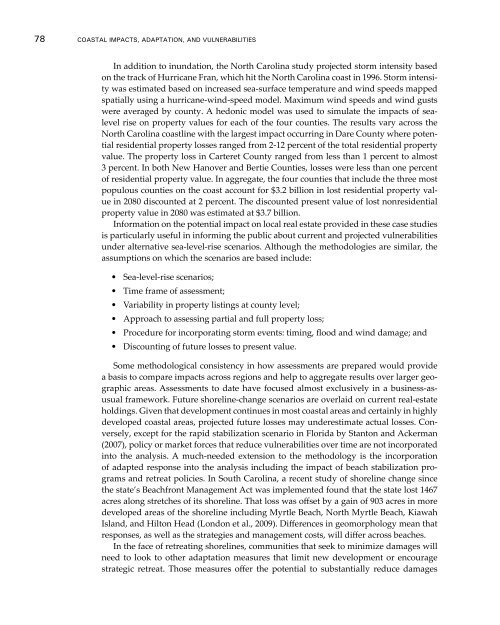Coastal Impacts, Adaptation, and Vulnerabilities - Climate ...
Coastal Impacts, Adaptation, and Vulnerabilities - Climate ...
Coastal Impacts, Adaptation, and Vulnerabilities - Climate ...
Create successful ePaper yourself
Turn your PDF publications into a flip-book with our unique Google optimized e-Paper software.
78 <strong>Coastal</strong> <strong>Impacts</strong>, <strong>Adaptation</strong>, <strong>and</strong> <strong>Vulnerabilities</strong>In addition to inundation, the North Carolina study projected storm intensity basedon the track of Hurricane Fran, which hit the North Carolina coast in 1996. Storm intensitywas estimated based on increased sea-surface temperature <strong>and</strong> wind speeds mappedspatially using a hurricane-wind-speed model. Maximum wind speeds <strong>and</strong> wind gustswere averaged by county. A hedonic model was used to simulate the impacts of sealevelrise on property values for each of the four counties. The results vary across theNorth Carolina coastline with the largest impact occurring in Dare County where potentialresidential property losses ranged from 2-12 percent of the total residential propertyvalue. The property loss in Carteret County ranged from less than 1 percent to almost3 percent. In both New Hanover <strong>and</strong> Bertie Counties, losses were less than one percentof residential property value. In aggregate, the four counties that include the three mostpopulous counties on the coast account for $3.2 billion in lost residential property valuein 2080 discounted at 2 percent. The discounted present value of lost nonresidentialproperty value in 2080 was estimated at $3.7 billion.Information on the potential impact on local real estate provided in these case studiesis particularly useful in informing the public about current <strong>and</strong> projected vulnerabilitiesunder alternative sea-level-rise scenarios. Although the methodologies are similar, theassumptions on which the scenarios are based include:• Sea-level-rise scenarios;• Time frame of assessment;• Variability in property listings at county level;• Approach to assessing partial <strong>and</strong> full property loss;• Procedure for incorporating storm events: timing, flood <strong>and</strong> wind damage; <strong>and</strong>• Discounting of future losses to present value.Some methodological consistency in how assessments are prepared would providea basis to compare impacts across regions <strong>and</strong> help to aggregate results over larger geographicareas. Assessments to date have focused almost exclusively in a business-asusualframework. Future shoreline-change scenarios are overlaid on current real-estateholdings. Given that development continues in most coastal areas <strong>and</strong> certainly in highlydeveloped coastal areas, projected future losses may underestimate actual losses. Conversely,except for the rapid stabilization scenario in Florida by Stanton <strong>and</strong> Ackerman(2007), policy or market forces that reduce vulnerabilities over time are not incorporatedinto the analysis. A much-needed extension to the methodology is the incorporationof adapted response into the analysis including the impact of beach stabilization programs<strong>and</strong> retreat policies. In South Carolina, a recent study of shoreline change sincethe state’s Beachfront Management Act was implemented found that the state lost 1467acres along stretches of its shoreline. That loss was offset by a gain of 903 acres in moredeveloped areas of the shoreline including Myrtle Beach, North Myrtle Beach, KiawahIsl<strong>and</strong>, <strong>and</strong> Hilton Head (London et al., 2009). Differences in geomorphology mean thatresponses, as well as the strategies <strong>and</strong> management costs, will differ across beaches.In the face of retreating shorelines, communities that seek to minimize damages willneed to look to other adaptation measures that limit new development or encouragestrategic retreat. Those measures offer the potential to substantially reduce damages
















